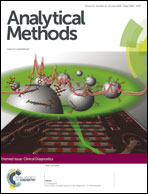Enantioseparations of three amino alcohols using a di-n-butyl-l-tartrate–boric acid complex as the mobile phase additive by reversed-phase high performance liquid chromatography
Abstract
Three amino alcohols, propranolol, clenbuterol and cycloclenbuterol, were enantioseparated on an achiral column by reversed-phase high performance liquid chromatography (RP-HPLC). A chiral chromatographic system was established based on C18-bonded silica gel as the support and a self-prepared di-n-butyl-L-tartrate–boric acid complex as the chiral mobile phase additive. In order to obtain better enantioseparations, the influences of di-n-butyl-L-tartrate and boric acid concentrations, the type, concentration and pH of the buffer, as well as methanol content were extensively investigated. It was found that the mobile phase composition played an important role in improving the enantioseparations and all of the enantiomers could be baseline resolved under the optimized experimental conditions. Three pairs of enantiomers, which could not be separated with only di-n-butyl-L-tartrate, obtained good chiral separations using the complex chiral selector. The primary driving forces responsible for the chiral recognition were assumed to be the ion-pair interaction between the enantiomers and the chiral selector; and the interactions between the ion-pairs above and the stationary phase also played important roles for the chiral separations in RP-HPLC.


 Please wait while we load your content...
Please wait while we load your content...